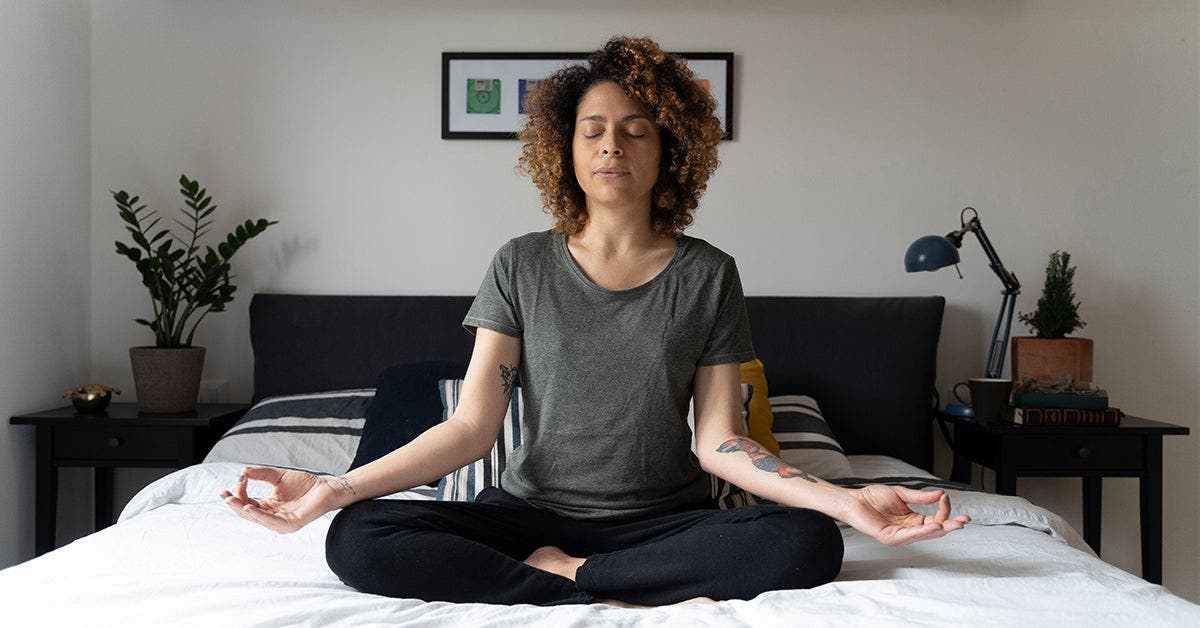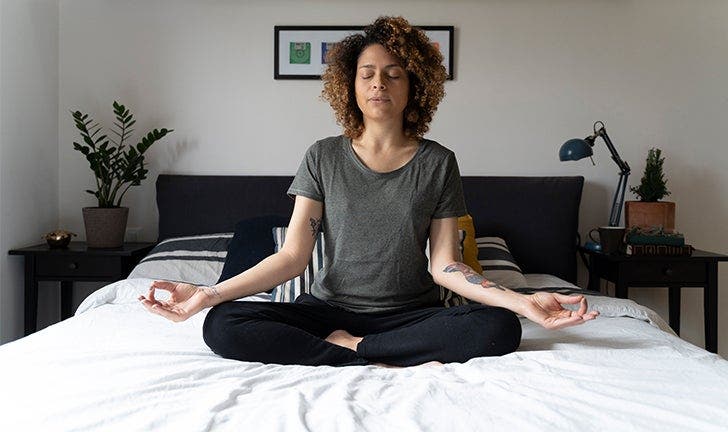Can meditating before bed help you sleep?


Sleep may be natural and necessary, but that doesn’t mean it always comes easily. If only! Insomnia—having trouble falling and/or staying asleep—affects up to 30% of adults, according to the American Academy of Sleep Medicine. And for many people, stress and anxiety are the most common sleep saboteurs, says Michael J. Breus, PhD, a diplomate of the American Board of Sleep Medicine.
If stress or racing thoughts have left you tossing and turning lately, trying a meditation technique may help. A study published in JAMA Internal Medicine found that people who practiced meditation for 20 minutes a day slept significantly better at night and were less tired during the day than people who didn’t meditate. Read on to discover more about meditation for sleep, and five step-by-step techniques to consider trying.
How does meditation help you sleep?
To answer that question, it helps to first understand how anxiety affects the body. “When you’re under stress, your body releases hormones—including adrenaline, cortisol, and norepinephrine—that prime your body for ‘fight or flight,’” Dr. Breus says. “These hormones rev your blood pressure and heart rate, making it tough to fall or stay asleep.” This can set off an unwelcome cycle: Fatigue the following day can exacerbate stress, messing with sleep again at bedtime.
In terms of insomnia, meditation may help by dialing down the body’s responses to stress. If you’re new to the idea of meditation, you might be more familiar with the concept of mindfulness: a nonjudgmental awareness of thoughts, feelings, and sensations in the present moment. You can practice mindfulness in pretty much any situation—whether you’re enjoying a meal or driving through rush-hour traffic.
Meditation exists in the same realm but is generally a more intentional act—a mind-body practice you do in a quiet setting during time you’ve set aside for that purpose, according to the National Center for Complementary and Integrative Health. Regularity is part of meditation, too: Over time, you learn to continuously bring your attention back to the present to help develop a greater sense of focused calm and awareness.
Research has found that meditation may lower blood pressure and improve heart rate variability (a physiological indicator of stress). Meditation was also correlated with increased production of the sleep-promoting hormone melatonin in a study published in Biological Psychology.
Sleep meditation tips
Interested in giving sleep meditation a try? These pointers can help you get started.
- Build it into your bedtime routine: Granted, meditating at any point during the day can help set the stage for a more restful night’s sleep, but doing so near bedtime can give your brain a more direct memo to start winding down, says Thanuja Hamilton, MD, a sleep medicine specialist with Advocare Sleep Physicians of South Jersey. “Try it half an hour before bed to give your body a signal that sleep is on the horizon,” she says.
- Choose a quiet space: Some people prefer to meditate in bed, while others retreat to a comfy nook in the living room or even a favorite chair in the backyard. The goal simply is to choose a location where you won’t be interrupted or distracted, says Dorsey Standish, a mindfulness and meditation coach in Dallas, Texas.
- Start with short sessions: It can take time to get used to meditation; for this reason, Standish advises beginning with just a few minutes per day, gradually working your way up to 20 minutes or so (the duration several studies have found is helpful). Setting a timer on your phone can help you stay focused on the practice instead of wondering how much time has elapsed since your session started.
- Give it time to work: Don’t be surprised if stress doesn’t melt away like magic with just a few soulful breaths. “Meditation is like taking your brain to the gym and training it,” Standish says. In other words, you might need a few weeks to get into the groove before you start to notice impacts on your mood and sleep.
Sleep meditation techniques
Pretty much any form of meditation can support healthy sleep, Standish says, so try experimenting with different methods until you find one that feels right for you. Here are five meditation techniques commonly used for better sleep:
Deep belly breathing
Slowly breathing as you raise and lower your belly can help restore calm, since research shows it reduces levels of the stress hormone cortisol. This “diaphragmatic breathing” also helps put the brakes on the fight-or-flight reflex by stimulating the part of your nervous system that controls the brain’s relaxation response.
How to do it:
- Step 1: Sit or lie down in a comfortable position with your eyes closed.
- Step 2: Inhale through your nose for a count of 4 as you fill your belly with air; hold the breath for 4 counts; then, exhale for 8 counts as you flatten your belly.
- Step 3: Repeat the breathing sequence 10 times. It’s OK if your mind drifts to your to-do list, Standish says. Instead of working to squash your stressful thoughts, bring your focus back to your breathing.
Body scan meditation
This form of meditation can be useful if you tend to experience physical signs of stress—for instance, in the form of muscle tension. “A body scan is about sequentially relaxing each part of the body,” says Rachel Rose, a yoga and meditation instructor at SHA Wellness Clinic in Alicante, Spain. She adds this technique is an aspect of Mindfulness-Based Stress Reduction, a formal program widely used in workplace settings.
- Step 1: Lie on your back with your eyes open or closed. Take a few slow breaths to start.
- Step 2: Inhale slowly as you direct your focus to your lower extremities. Imagine the tension held in your far-lower body, and be with the feeling as you breathe in.
- Step 3: Exhale and focus on relaxing the muscles in that localized area. Allow the tension to leave as you breathe out. You may find it helpful to narrate the moment in your mind with a thought like, “My feet are now completely relaxed.”
- Step 4: Repeat the inhaling-exhaling sequence as you work through different parts of the body—legs, arms, back, shoulders, and so on—all the way up to your neck and head.
Gratitude meditation
When challenges arise in life, tunnel vision sometimes takes over and we can end up focusing on everything that’s going wrong, Standish says. Directing our focus to gratitude can help restore perspective, she explains, which may improve sleep. In one study, volunteers who made a nightly list of things they were grateful for before bed slept better and woke up feeling more refreshed than people who jotted down things that bothered them. Think of gratitude meditation as a mental version of writing that list.
How to do it:
- Step 1: Sit quietly with your eyes open or closed. Think about a positive event that recently happened in your life—for example, getting outdoors on a gorgeous afternoon. Reflect on a specific reason you’re grateful it happened. For example, “I’m grateful that spending time in nature helped me feel connected to something bigger than myself.”
- Step 2: Next, think about a relationship that’s important to you—whether with a friend, partner, child, community member, even a pet. Reflect on a specific reason you appreciate this relationship. For example, “I feel so cared-for when my neighbor checks in on me to see how I am doing.”
- Step 3: Next, think about an object you appreciate, and focus on a specific reason it inspires thankfulness. For example, “I’m so grateful to have inherited my grandmother’s handmade quilt; it sparks my own creative spirit.”
- Step 4: Last, think about you. Focus on a specific quality you appreciate about yourself. It can be as simple as, “I’m grateful I have two strong legs that carry me through this world” or “I’m grateful for the passion and ideas I can use to make my community better.”
Guided meditation
Guided meditation is any meditation practice that’s led by another person—a helpful option if you’re not quite sure where or how to start. An instructor generally helps set the stage for relaxation by directing your focus, then takes you through a mindfulness exercise step by step. Guided meditations vary in length—some are as short as five minutes—and are available in person, by live video, and through recordings. For guided sleep-meditation audio exercises, check out Headspace on the WW app.
Walking meditation
Be honest: Does the mere thought of meditation make you feel a bit fidgety? A walking practice might work for you, Standish says. The goal isn’t to “exercise” or even get from point A to point B. The objective is to simply move within a small area to help you train your focus on the physical sensations of your body. Walking meditation is a form of moving meditation—doing a series of sun salutations or practicing qigong can provide similar benefits.
How to do it:
- Step 1: Stand at one end of a hallway, room, or outdoor walkway.
- Step 2: Slowly stroll to the other side, pause, and walk back to the starting point.
- Step 3: As you move, focus on the sensations in your body. Think about the feeling of your belly filling with air, the pressure as your foot takes a step, the feeling as your arms swing at your sides. Continue, slowly walking back and forth, for 3 to 5 minutes.
The upshot: Meditation can support better sleep
Insomnia has many possible causes, so there’s no cure-all. But if your sleep troubles are stress-related, a meditative practice may help you score better slumber. Over time, meditation techniques—including body-scan meditation, gratitude meditation, and more—may help dial down the body’s stress responses for a calming effect that reduces anxiety at bedtime. For best results, experts recommend meditating regularly in a setting with minimal distractions. If sleep doesn’t improve after a few weeks of meditation—or if you suspect your sleep issues go beyond stress and anxiety—you might benefit from developing a more comprehensive plan with your doctor.
--
Barbara Brody is a freelance writer who specializes in health and wellness. Her work has appeared in a wide variety of outlets including WebMD, Health, and Prevention.
